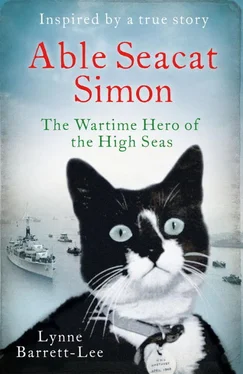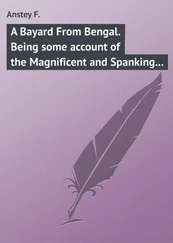Keeping ‘mum’, I soon learned, was a very important thing. And having responsibility for keeping it (and the men’s faith that I could be trusted to, of course) always made me feel close to my own mother.
None of this was a part of my mother’s plan for me, however. Far from it. I’d catch myself (as likely when cuddled up in a sleeping sailor’s hammock as when presenting a lifeless rat to the captain) in a state of bemused wonder. Specially at those times when the stars were at their brightest – at three or four or five in the morning, perhaps while I was sitting on some sheltered part of the upper deck, watching flying fish skim the water, perhaps sitting in the humming warmth of the wireless room, perhaps curled up on my favourite spot up on the bridge. I’d be sitting companionably with the captain, or Lieutenant Weston (or even Lieutenant Berger, however much he kept declaring himself not to be ‘a cat person’) and wishing so hard that my mother could see for herself that humans – at least the ones on His Majesty’s Ship Amethyst – were not the monsters she’d supposed.
It was the strangest thing – I had gone from being an outsider, a loner, a scared, scavenging kitten, to being a valued member of a team. No longer hiding in the shadows, for fear of being seen and mistreated, here I was treated daily to titbits and cuddles and strokes. It made no sense, because these were not things a cat should desire, yet at the same time I had never felt so happy. And as the days turned into weeks, and the weeks into months, I realised that solitude was not only overrated, it was the least likely thing I’d be now inclined to choose, with a human lap the most likely, any day.
There was a great deal to learn about life in the Navy, and I was eager to learn it. Not least (as it was key to almost everything on board) the many ways my human friends communicated with one another, which was something they seemed to like to do almost all the time, even more so – and this was a revelation too – than the ever barking, ever sniffing, ever tail-wagging Peggy.
Yes, they spoke to each other, of course, and for the most part, that was easy to grasp. Had Captain Griffiths been a cat, the Amethyst would very much be his territory, though, unlike a cat, he didn’t need to defend it alone; he had all his men, who deferred to him at all times and in all things, to assist him in doing it.
Then there were things called flags, of which there seemed to be many; not just the ensign that flew from the top of that masthead to let everyone know who we were. There was a big store of flags below, each in its own designated cubby hole, all of them made of a mix of different coloured cloths, all of them enticing to a cat in want of a nap. Though I learned very quickly that a cat in want of a nap might – no, would – do much better to take it elsewhere, because (as the signals officer was at great pains to relay when he ejected me) no one interfered with his bunting. I wasn’t sure what he meant by ‘bunting’ but, as ever, his tone was very clear; that everything to do with flags – hoisting them, flying them and then bringing them down again and refolding them – was taken very seriously indeed.
Closer to home, there were myriad different ways by which everyone communicated on board. As well as everyone being called different things by different people (which was why I’d been gifted two names, I supposed) there was a big noisy bell, which was rung periodically, as well as a bewildering number of different whistles, which were blown in so many ways, and for so many apparent reasons, that I never knew if there was going to be a sudden invasion of mops and buckets or a very important person coming aboard.
Most curious of all, though, were the serpentine devices that wound their way around the Amethyst and, by some magic that I had yet to understand (and perhaps never would), enabled everyone to speak to whoever they wished to speak to, in whichever compartment of the ship they happened to be.
They were strange things – a little too unnervingly snakelike, to my mind – but without doubt, very clever indeed: lidded metal tubes that began in one place – say, the bridge – and ended up somewhere else – say the wireless room or wheelhouse – carrying words wherever words needed to be.
‘That’s called a voice pipe,’ the captain told me, when I was up on the bridge with him one morning, sitting on the ship’s compass (which being glass-topped, was always nice to sit on when the sun happened to be shining, though best avoided if there was a nip in the air). The pipe was adjacent, and I was busy making a closer inspection of it. ‘And, let me tell you, young fellow, if you let your curiosity get the better of you and decide to see where it might take you, you’ll be in for an extremely rude awakening.’ He’d laughed then. ‘And probably get stuck fast then, as well, even being the little tiddler you are.’
I had no idea what a rude awakening might feel like, but I was definitely more than familiar with being ‘stuck’, having never forgotten being stuck up a tree. It was sufficient to deter me from investigating them any further.
Most fascinating of all, though, were the machines that went tap-tap-tap-tap and lived in the wireless room. It was a place that had quickly become a favourite haunt for me anyway – what with all the paper lying around (‘very important bits of paper!’ Jack would huff, every time he shifted me off from them) – it had lots of very cat-friendly features. But the machines were particularly interesting. They didn’t look much, but could apparently send important messages all around the world, just by the operator (of which Jack was one) tapping bits of wood against one another.
There was something mesmeric about the tap-tap machines, so much so that I’d spend long periods dozing beside the telegraphists – Jack in particular. This had initially been because his preferred snack was a herring sandwich, but latterly just because, well, because Jack was Jack, and there was so much with Jack that was tacitly understood. I sometimes wondered if Jack could tell what I was thinking.
I could see him doing it, despite the fact that the main thing about the tap-taps was their ability to put me, if not quite to sleep, in that delicious drowsy half-sleep that cats like the best; my ‘meditations on the mouse’, as George once had put it.
‘Shall I tell you what this is?’ Jack explained to me. ‘This here is what’s known as a code machine. Named after a chap called Samuel Morse – since you obviously want to know that – who was something of a clever man, and who helped devise a way of communicating using pulses of electricity, and that’s really all you need to know.’
He was wrong about that – ideally I’d have liked to know everything about everything – but I was happy enough, for now anyway, just to understand the principle. And once again to discover that humans, working together, were so much more the sum of all their parts, all of them contributing in different ways to achieving the amazing variety of things humans seemed to want to do.
But I had another thing to learn in those early months on board the Amethyst. That just when you are growing content, thinking everything is exactly as you like it, life has a way of seeing to it that you get something else.
Change was a normal part of life in the Navy; I had quickly learned that. You followed your orders and went wherever you were told. As did the Amethyst . We sailed and we docked and we oiled and replaced supplies, and by the end of the year we had travelled all over the ocean – and also up a river; the mighty Yangtse, to Nanking.
But, as well as that, people came and people went. First George, gentle George, who I would be forever grateful to, and who was posted off to another ship that autumn.
Читать дальше












